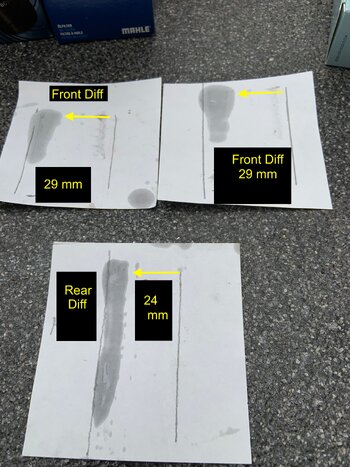You do understand these have nothing to do with each other right? The problem you're mentioning would exist regardless of how much oil is in the diff.There is a flaw in early breathers. I am happy yours is not among them, nonetheless it is a problem.
The Grenadier Forum
Register a free account today to become a member! Once signed in, you'll be able to contribute to the community by adding your own topics, posts, and connect with other members through your own private inbox! INEOS Agents, Dealers or Commercial vendors please use the contact us link at the bottom of the page.
-
Guest submit your best shot for a chance to win the December Photo Contest. Photo Contest Click Here
You are using an out of date browser. It may not display this or other websites correctly.
You should upgrade or use an alternative browser.
You should upgrade or use an alternative browser.
Diff oil level measuring tool?
- Thread starter Pete Brown
- Start date
- Local time
- 4:19 PM
- Joined
- Oct 2, 2023
- Messages
- 619
My point was only as these diffs heat up they build pressure internally and overfilling them exasperates the issue. I changed the differential fluids on my rig and the sound of air escaping the differentials when I pulled the covers was audible after a drive to get them up to temperature.i'm corn fused. ....
heat (T) is caused by friction (u) . i can't take an equation and directly substitute friction for heat. and how does friction "cause" pressure, that's heats job? ln(P2/P1) = (ΔHvap/R) * (1/T1 - 1/T2). I'm not seeing friction in here. ironically, diff fluid mitigates friction, as that's why its there in the first place. I'm not certain how 4 more oz of fluid is going to cause friction and therefore heat. The only way more oil could be a functional part of your theory, would be the ΔHvap, but if it really was that much pressure (which its not, btw as more oil would be a heat sink as it touched the casing) that's what the valve is for. so, if your seal is leaking from pressure, its not the fluid, its the breather not working, and more fluid will not cause a breather not to work as it cannot be filled to full or close to it. the location of the fill hole is deliberate. notice its not on the top? its where it is so it cannot be overfilled and prevent any sort of drag or foaming. the gear needs to slosh thru it and spray it, not be submersed in it. plenty of space is maintained.
If they want you to fill below the hole, it's because the oil will expand a little with the temperature, and leak out if opened when warm, if filled to the edge when cold. If you feel a few drips leaking out of the diff hole on the off chance you open the plug when hot, is going to change the crash course the planet is headed on, by all means, buy a special tool to measure. I've given up on saving the planet. I'm sticking with my pinky.
Unfortunately, per my dealer, trucks are still blowing seals even with the aftermarket arb vent tubes which simply vent to atmosphere. So that would lead one away from concluding it's the factory vents that are the problem. Regarding ammount of oil and filling procedure, we should have full clarity with the release of the factory service manual, correct?
Filling to the hole bottom does none of what you are attributing to it, and valves are not free flowing holes. If its to let air flow in both directions, SOME pressure or vacuum is required to open.My point was only as these diffs heat up they build pressure internally and overfilling them exasperates the issue. I changed the differential fluids on my rig and the sound of air escaping the differentials when I pulled the covers was audible after a drive to get them up to temperature.
Am I to understand you pulled the valve cover off, without the drain plug being pulled? I'm not understanding. Wouldn't you pull the plugs and rain before removing the cover? if so, where would the air pressure come from?
My experience... I filled the diff with oil until it started to drain out, just like I've always done. After freeway driving the underside of my Grenadier was covered in gear oil. Stuck breather? Maybe? I drained a little oil out of the diff and haven't had a problem since. Next time I will fill the diff with 2.1 liters as specified by Ineos and not fill till it spills out.
This issue has been discussed several times before. The proper level is 23mm or about an inch below the fill hole
This issue has been discussed several times before. The proper level is 23mm or about an inch below the fill hole
And which diffs from any previous era do not produce heat and subsequently pressure if the vent is either a pop valve or just inadequate. The axles on the Grenadier might as well have been manufactured in the 80' considering their design. You are confusing causation and correlation.My point was only as these diffs heat up they build pressure internally and overfilling them exasperates the issue. I changed the differential fluids on my rig and the sound of air escaping the differentials when I pulled the covers was audible after a drive to get them up to temperature.
- Local time
- 4:19 PM
- Joined
- Oct 2, 2023
- Messages
- 619
I’m not so sure they weren’t.And which diffs from any previous era do not produce heat and subsequently pressure if the vent is either a pop valve or just inadequate. The axles on the Grenadier might as well have been manufactured in the 80' considering their design. You are confusing causation and correlation.
It seems there is still confusion with the diff oil levels. The dealer is telling me that the level is, qoute “the level is in line with the fill bung.” yet when I read the workshop manual I get
NOTE: If the oil flows out of the Differential Cover when you remove the Fill Plug remove oil until it is set to the correct level.
Remove the Fill Plug from the Front Differential Cover.
NOTE: Repeat steps 4 and 5 as necessary until the oil level is correct.
Use SSTxxx 1
o do a check of the Differential Oil level.
NOTE: The Differential Housing must contain a maximum oil quantity of 2.1 l.
NOTE: If the oil flows out of the Differential Cover when you remove the Fill Plug remove oil until it is set to the correct level.
Remove the Fill Plug from the Front Differential Cover.
NOTE: Repeat steps 4 and 5 as necessary until the oil level is correct.
Use SSTxxx 1
o do a check of the Differential Oil level.
NOTE: The Differential Housing must contain a maximum oil quantity of 2.1 l.
Still no difinitive answer on the diff oil fill level:
The service manual refers us to use "SSTxxx" to check the diff oil level but does not indicate what the SSTxxx tool is or at what level the diff oil should be at. Just says to not fill with more than 2.1Litres. No reference to the oil level needing to be 23mm below the fill port as others have previously mentioned on the forum.

The service manual refers us to use "SSTxxx" to check the diff oil level but does not indicate what the SSTxxx tool is or at what level the diff oil should be at. Just says to not fill with more than 2.1Litres. No reference to the oil level needing to be 23mm below the fill port as others have previously mentioned on the forum.
I don't quite understand the designation of the special tool. Is the "xxx" a redaction? If not it would have to be in a service parts list somewhere.
I’ve asked my dealer and they don’t have such tool whatever it is.
Because nobody uses it or it simply doesn't exist.I’ve asked my dealer and they don’t have such tool whatever it is.
Fill till it is at the level of the fill hole and move on with your life. Even just a slight slope in your driveway will change things a fair bit. But it won't change a thing, if you're mostly level you will be within spec.
There is no magic here.
After about 23,000 km, I've changed the oil in my differentials a total of three times. The first time was because the dealer forgot to do it, and now to take the measurements.
The factory oil level was 2.1 liters at the first oil change.
Today, I filled both differentials with exactly 2.1 liters. The oil in the front differential was afterwards 29 mm below the filler hole, and in the rear differential 24 mm below.
I measured the oil level with a wire hook, which I then drew along a line on a piece of paper. This makes it easier to see the oil level when the oil is new and clean. Both differentials were cold when I took the measurements.
To see how much oil was actually going into the differentials, I tried overfilling the rear differential before draining the old oil. After I had quite laboriously filled it with about 1 liter of oil using a squeeze bottle, I stopped and measured again. The oil level was now about 10 mm below the filler hole.
I then drained a total of 3 liters of oil from the differential, and there were still 10 mm to the filler opening. I suspect that at least 3.5 liters of oil can be poured into the differentials when filling to the overflow.
When researching online about changing the differential oil, all you ever find is the advice that they should be filled to the overflow. Since Ineos differs from all other manufacturers I know in this regard, I wish they had given some information about why their differentials should only be filled with so little. Perhaps someone should ask Lynn Calder this question.
I can't really see any reason why you should measure the oil level if you've filled exactly the required amount of 2.1 liters.
The only reason why measuring it might make sense, is the way you fill the oil.
At the factory, filling is probably done with a pump that shuts off at exactly 2.1 liters.
We DIY enthusiasts, on the other hand, use pumps that aren't designed for precise filling.
I myself have a pump with a 7-liter reservoir.
If I only fill 2.1 liters into this reservoir, I would be putting too little oil into the differential, as the pump and the 1-meter hose themselves need a certain amount of oil to function at all. Of course, you can add a certain amount of oil to the reservoir beforehand and then hope that there are exactly 2.1 liters of oil in the differential, but that doesn't always work. To determine the exact oil level under these circumstances, a measurement would be useful.
Filling the oil into the differentials on the Ineos isn't as easy as it seems, as the tie rods are in the way at both, the front and rear. Filling it on the go, for example, with a squeeze bottle, would be quite difficult.
For myself, I've decided that in the future, I'll use my pump to fill the differential with enough oil so that the oil level is just over the required 2.1 liters. With a possible total capacity of approximately 3.5 liters, I can't imagine it making any difference whether the differential contains 2.1 or 2.2 liters. However, if it does make a difference, I'd be happy if Ineos could explain it to me.
The factory oil level was 2.1 liters at the first oil change.
Today, I filled both differentials with exactly 2.1 liters. The oil in the front differential was afterwards 29 mm below the filler hole, and in the rear differential 24 mm below.
I measured the oil level with a wire hook, which I then drew along a line on a piece of paper. This makes it easier to see the oil level when the oil is new and clean. Both differentials were cold when I took the measurements.
To see how much oil was actually going into the differentials, I tried overfilling the rear differential before draining the old oil. After I had quite laboriously filled it with about 1 liter of oil using a squeeze bottle, I stopped and measured again. The oil level was now about 10 mm below the filler hole.
I then drained a total of 3 liters of oil from the differential, and there were still 10 mm to the filler opening. I suspect that at least 3.5 liters of oil can be poured into the differentials when filling to the overflow.
When researching online about changing the differential oil, all you ever find is the advice that they should be filled to the overflow. Since Ineos differs from all other manufacturers I know in this regard, I wish they had given some information about why their differentials should only be filled with so little. Perhaps someone should ask Lynn Calder this question.
I can't really see any reason why you should measure the oil level if you've filled exactly the required amount of 2.1 liters.
The only reason why measuring it might make sense, is the way you fill the oil.
At the factory, filling is probably done with a pump that shuts off at exactly 2.1 liters.
We DIY enthusiasts, on the other hand, use pumps that aren't designed for precise filling.
I myself have a pump with a 7-liter reservoir.
If I only fill 2.1 liters into this reservoir, I would be putting too little oil into the differential, as the pump and the 1-meter hose themselves need a certain amount of oil to function at all. Of course, you can add a certain amount of oil to the reservoir beforehand and then hope that there are exactly 2.1 liters of oil in the differential, but that doesn't always work. To determine the exact oil level under these circumstances, a measurement would be useful.
Filling the oil into the differentials on the Ineos isn't as easy as it seems, as the tie rods are in the way at both, the front and rear. Filling it on the go, for example, with a squeeze bottle, would be quite difficult.
For myself, I've decided that in the future, I'll use my pump to fill the differential with enough oil so that the oil level is just over the required 2.1 liters. With a possible total capacity of approximately 3.5 liters, I can't imagine it making any difference whether the differential contains 2.1 or 2.2 liters. However, if it does make a difference, I'd be happy if Ineos could explain it to me.
Attachments
Someone should ask Carraro how they fill their axles.
Delivered empty to Ineos to reduce weight, and spillage in transit.Someone should ask Carraro how they fill their axles.
The Ivecos and tractor front axles we just filled to spill with no issues.
The Iveco Daily 4x4 used the larger Carraro axles (about Dana 70 size) and with the info I have, these axles required 3.2 litres of oil but because of how the rear axle was fitted in the truck to get the 3.2l in the axle it was suggested to point the truck front down.
Plug location in the cover looks to be the main contributor to the no fill to spill oil level for the Grenadier.
Iveco Rear axle

Ineos Rear axle. Fill plug above the axle centre line?

Plug location in the cover looks to be the main contributor to the no fill to spill oil level for the Grenadier.
Iveco Rear axle
Ineos Rear axle. Fill plug above the axle centre line?
Wanna flip a coin to know if the mechanic working on your Grenadier has any idea that fill to spill versus 31mm using an Allen wrench is a thing? We should poll as many ASE certified mechanics as we can and ask, what do you normally do with diff fills, fill to spill or not, and why not? But heck, even if INEOS, or Magna Steyer, says one way or the other, who said it, and do they know? Man, knowing things is really hard.Wow, I most certainly hope you aren't right. But that sounds way too plausible.
Based on what I have seen at Ineos I'm certain I know the answerWanna flip a coin to know if the mechanic working on your Grenadier has any idea that fill to spill versus 31mm using an Allen wrench is a thing? We should poll as many ASE certified mechanics as we can and ask, what do you normally do with diff fills, fill to spill or not, and why not? But heck, even if INEOS, or Magna Steyer, says one way or the other, who said it, and do they know? Man, knowing things is really hard.
I've learned, too often the hard way, few of us can know with certainty much of anything. Talk to one person at INEOS, then another, you'll get different answers, both from engineers, but that's human nature, not INEOS, or INEOS's fault. True of any subject in any group or company or govt agency. When I've been asked questions as a NASA engineer it's hard to say, well, let's get some evidence, I have the urge to think I know and to say it. Testing stuff is hard, takes time, money it's arduous, and change any variable, and things change again. Look how many debates on oil viscosity and other stuff is on this forum, or on the BMW forums, or any forum. My comment was that nobody really knows, or we haven't talked to the person who does know because they've done the testing and have the evidence. And we never know when we're talking to the 'right' person. I think we have to decide when to do things ourselves, and do whatever research we can to understand the issue or what we're trying to do and then, well, who knows if we got it right? Knowing things is hard.Based on what I have seen at Ineos I'm certain I know the answer
There is also always the chance of Six in one and half a dozen in the other. Don't stress it, most people don't keep vehicles much past 100k miles and then even fewer that make it past 200k miles. Hell many owners are just too old to even expect 100k miles in their lifetime.I've learned, too often the hard way, few of us can know with certainty much of anything. Talk to one person at INEOS, then another, you'll get different answers, both from engineers, but that's human nature, not INEOS, or INEOS's fault. True of any subject in any group or company or govt agency. When I've been asked questions as a NASA engineer it's hard to say, well, let's get some evidence, I have the urge to think I know and to say it. Testing stuff is hard, takes time, money it's arduous, and change any variable, and things change again. Look how many debates on oil viscosity and other stuff is on this forum, or on the BMW forums, or any forum. My comment was that nobody really knows, or we haven't talked to the person who does know because they've done the testing and have the evidence. And we never know when we're talking to the 'right' person. I think we have to decide when to do things ourselves, and do whatever research we can to understand the issue or what we're trying to do and then, well, who knows if we got it right? Knowing things is hard.
Non of this really makes much of a difference at 100K. And debatably even at 200k. Diffs last forever seemingly as long as you keep the water out and the skinny pedal foot light when the tires are spinning.
Similar threads
- Locked
- Replies
- 313
- Views
- 26K




